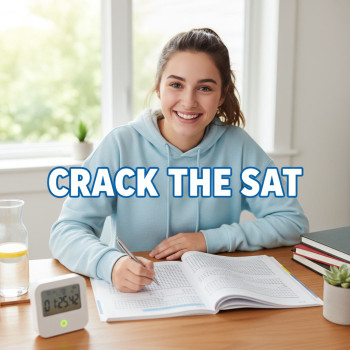AP vs SAT: Practice Testing How Much Is Enough?
Opening Note: Why This Question Matters
Ask any student or parent wrestling with test prep and you ll hear a familiar worry: how many practice tests are enough? Too few and you re underprepared, too many and you burn out or waste time that could be spent reviewing weak points. The answer isn t a single number for everyone. It s a strategy that balances quality practice, targeted review, and mental stamina. In this post we ll map out practical, easy-to-follow guidance for AP exams and the Digital SAT, compare the two experiences, and give you a realistic schedule you can personalize plus tips for using 1-on-1 support like Sparkl s personalized tutoring where it fits naturally into your plan.
Understanding the Tests: Different Goals, Different Practice
Before determining the how many, it helps to be clear about what each test demands.
AP Exams: Depth, Content Mastery, and Timing
AP exams assess mastery of a subject history, calculus, biology, English, and many more. They often include free-response or essay components that require not just recalling facts but organizing written arguments or solving multi-step problems. Practice tests for AP are best used to gauge content knowledge, pacing for long constructed-response sections, and the ability to apply concepts under pressure.
Digital SAT: Strategy, Pacing, and Problem Types
The Digital SAT focuses on reasoning across reading, writing, and math with a particular emphasis on strategy and time management. Because it s delivered digitally, familiarity with the test interface, on-screen tools, and the pacing of shorter adaptive sections matters a great deal. Practice tests help you refine timing strategies, get comfortable with digital navigation, and recognize common question patterns.
Why Practice Tests Work And When They Don t
Practice tests are the single best simulation of real test conditions. They reveal gaps you didn t know you had, teach you how to manage test-day nerves, and provide measurable progress. But they can also be misleading if used poorly:
- Taking tests without reviewing mistakes turns them into busywork.
- Randomly timed tests don t help with pacing habits.
- Doing many low-quality, distracted practice tests can create false confidence.
So the real question becomes: how many high-quality, well-reviewed practice tests are enough?
Guidelines: How Much Practice Testing Is Enough
Below are evidence-informed, practical guidelines you can adapt based on baseline ability, target score, and time until test day.
1. Baseline Assessment (Start Here)
Take one full, timed practice test early. Treat it like a diagnostic: don t overreact to the score. Use it to identify weak areas, pacing problems, and the types of questions that take you longest. For AP: choose a released exam or a full practice exam in the same format (multiple choice + free response). For Digital SAT: take a full digital practice test in the test s format.
2. Active Review After Every Test
This is non-negotiable. After each practice test, spend at least twice the test time reviewing mistakes. That means:
- Rework each incorrect question until you can explain the correct answer in your own words.
- Keep a mistake log that tracks question type, error cause (conceptual, careless, timing), and a short correction plan.
- For AP free-response, rewrite one or two high-value responses focusing on structure and evidence or show your math work more clearly.
3. Quality Over Quantity Rule
Fewer, deeply reviewed practice tests beat many passively taken tests. Aim for tests that mirror actual exam conditions. For the Digital SAT, use digital practice platforms to get used to on-screen navigation. For AP, use released College Board exam materials when possible for authentic practice.
4. Recommended Ranges (General)
Use these as starting points, then adjust to your individual needs.
| Time Until Test | Recommended Full Practice Tests | Focus |
|---|---|---|
| 3+ months | 4 8 | Diagnostics, pacing, incremental improvement, targeted review |
| 4 8 weeks | 2 4 | Simulate test day conditions, refine timing and strategies |
| Final 2 weeks | 1 2 (light) | Confidence building, light review, rest |
Note: These ranges assume regular targeted practice between full tests (practice sections, content review, and active drills).
AP vs SAT: How Practice Looks Different in Real Life
AP Practice Focus Areas
- Deep content review (specific facts, formulas, dates, and evidence).
- Long-form writing or multi-step problem practice for free-response sections.
- Subject-specific labs or document-based question (DBQ) simulations for history and science APs.
SAT Practice Focus Areas
- Timing drills and digital navigation practice (for the Digital SAT).
- Pattern recognition in question types (e.g., evidence-based reading, grammar rules, algebraic manipulations).
- Section-level practice: short, focused sessions to build speed and confidence.
Sample Practice Schedules You Can Follow
Below are three sample plans depending on how much time you have. Each plan assumes outside-of-test practice (drills, review, content study).
Plan A: Long-Term Builder (3+ months)
- Month 1 2: One diagnostic test each month; weekly targeted drills (2 3 sessions/week)
- Month 3: Two full practice tests spaced two weeks apart with deep review
- Final 3 4 weeks: One full practice test per week, light review after the last one
Plan B: Moderate Prep (6 8 weeks)
- Weeks 1 3: Diagnostic + two section-level timed practices weekly
- Weeks 4 6: Full practice tests every 10 14 days with concentrated review
- Final week: One light full test 5 7 days before test day, then rest
Plan C: Crash Prep (2 3 weeks)
- Week 1: One diagnostic, immediate focused review on highest-error areas
- Week 2: Two full tests spaced 3 4 days apart with intense error analysis
- Final week: Light practice sections, rest, and logistics for test day
How to Make Every Practice Test Count
These tactical habits will make your practice tests more effective and less stressful.
1. Simulate Test Day
- Take practice tests in a quiet environment, timed exactly like the real test.
- For the Digital SAT, use the official digital interface if available to replicate navigation.
- Wear what you would wear on test day and practice breaks and snack timing.
2. Keep a Mistake Log
Track the question, the error type, the correction, and one action item. Over time this log becomes your goldmine of recurring issues to fix.
3. Mix Full Tests With Targeted Mini-Tests
A full test once a week is great, but shorter, targeted sessions focusing on weak areas will accelerate improvement. For AP, that may mean an hour on free-response structure or practicing DBQs; for SAT, a timed 25-minute reading passage or a 20-minute math section.
4. Review Strategically Don t Just Count Tests
Use spaced repetition for content and deliberate practice for skills. Active recall writing out answers, explaining mistakes aloud, or teaching a concept to a parent beats passive re-reading every time.
Emotional and Cognitive Readiness: The Often-Ignored Part
Test prep isn t only cognitive. Stress, sleep, nutrition, and confidence matter. Build small routines: sleep consistency in the week before test day, short breathing exercises during practice to simulate calm, and quick physical activity breaks to avoid mental fatigue. Sparkl s personalized tutoring programs often include not just content coaching but also strategies for pacing, stress management, and tailored study plans that fit your life if you value one-on-one help to weave these pieces together, targeted tutoring can be a game-changer.
When Fewer Tests Are Better
There are times when taking more tests is not the answer:
- If you aren t doing deep reviews after each test, stop and focus on remediation.
- If your practice tests are inconsistent in format or quality, switch to released or high-quality official practice materials.
- If you re mentally exhausted quality declines and errors increase, so rest is the right call.
Personalization: How to Tailor the Number to You
Use this short decision checklist to pick a target number of practice tests:
- Are you already scoring near your target? If yes, fewer, strategic tests (2 4) are likely sufficient.
- Does the test format feel unfamiliar (digital interface, long free-response)? Add practice tests to build comfort.
- How much time do you have? More time = more chance to space tests and review.
- Do you have targeted support (teacher, tutor)? If so, fewer tests with guided review can outperform many solo tests.
Example Personalization
Julia, a motivated junior aiming for a 4 on AP Biology with three months to go, should take an initial diagnostic, then 4 6 targeted subject tests over those months, with deep review of lab-based questions and three full simulations in the last 6 weeks. Marcus, a senior retaking the Digital SAT in six weeks, benefits from one diagnostic, weekly full digital practice tests (3 4 total), and frequent timed math/reading drills.
Practical Table: Checklist Before, During, and After Each Practice Test
| Stage | Actions | Why It Matters |
|---|---|---|
| Before | Set timer, quiet environment, materials ready, know rules | Reduces interruptions and simulates test conditions |
| During | Use test strategies, mark hard questions, note time checkpoints | Builds pacing habits and decision-making under pressure |
| Immediately After | Record raw score, quick emotional check (how you felt), then rest | Captures honest reaction and prevents fatigue from rushed review |
| Review Session | Detailed error analysis, update mistake log, plan targeted drills | Turns mistakes into durable learning |
How Tutoring Fits In Not as a Crutch, But as a Catalyst
Practice tests are more powerful when paired with personalized feedback. That s where 1-on-1 tutoring comes in. A good tutor can:
- Design a practice-test schedule that fits your personal timeline and learning style.
- Help analyze mistakes faster and translate them into focused drills.
- Offer emotional coaching and pacing strategies for test day.
For families considering extra support, Sparkl s personalized tutoring can offer tailored study plans, expert tutors who specialize in AP subjects and the Digital SAT, and AI-driven insights to help prioritize what to practice next. When used strategically, tutoring amplifies the value of every practice test you take.
Last-Minute Tips: What to Do in the Final 7 Days
- Limit full-length tests to one light simulation 5 7 days before test day.
- Focus on sleep and light review of high-yield material (formulas, key concepts, grammar rules).
- Do short, focused practice sessions rather than marathon studying.
- Prepare logistics test location, ID, materials, and healthy snacks.

What Success Looks Like
Success is not an arbitrary number of practice tests but measurable improvement in three areas:
- Accuracy on previously missed question types.
- Improved pacing finishing sections with time to spare or making better on-the-spot decisions about which questions to skip and return to.
- Stronger mental resilience reduced panic during unfamiliar questions and steadier performance across practice tests.
Concluding Advice: Be Strategic, Not Mechanical
There s no magic number of practice tests that guarantees success. Rather, use practice tests as diagnostic tools, learning experiences, and confidence builders. Prioritize high-quality materials, commit to deep review after each test, and plan tests with intention: fewer high-value practices are better than a pile of poorly reviewed attempts.
If you want a tailored roadmap how many tests you should take, which sections to prioritize, and how to structure reviews consider getting targeted help. Personalized tutoring, like Sparkl s 1-on-1 guidance, can turn your practice test results into an efficient action plan so every minute you spend studying moves you closer to your goal.

Final Checklist: Before Your Next Practice Test
- Set a clear purpose for the test (diagnostic, pacing practice, or confidence check).
- Ensure you ll do a thorough review schedule time for it now.
- Use the right format (digital for Digital SAT; official-level practice for AP).
- If overwhelmed, ask for help tutors can help you convert test data into progress.
Good luck. Take one test, learn from it, and let that learning guide the next one step by step you ll build the skills and the confidence to perform on exam day.



















No Comments
Leave a comment Cancel